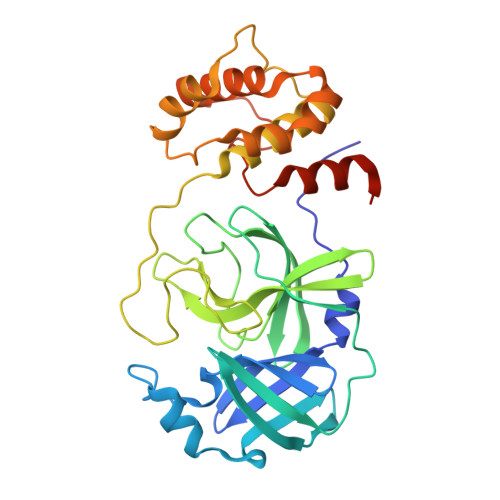Inhibition of dimeric SARS-CoV-2 Mpro displays positive cooperativity and a mixture of covalent and non-covalent binding.
Padmanabha Das, K.M., Chen, J., Charifson, P.S., Green, J., Tang, H., Panchal, S., Pu, F., Korepanova, A., Dubey, A., Afanador, G., Stojkovic, V., Nocek, B., Bigelow, L., Stubbs, S.H., Davey, R.A., DeGoey, D.A., Arthanari, H., Namchuk, M.N.(2025) iScience 28: 112773-112773
- PubMed: 40655098
- DOI: https://doi.org/10.1016/j.isci.2025.112773
- Primary Citation of Related Structures:
9DTZ, 9DU2, 9DU3, 9DU4 - PubMed Abstract:
SARS-CoV-2 Mpro is a cysteine protease that acts as a symmetrical dimer and displays positive cooperativity for substrate turnover. A series of potent reversible covalent peptidomimetic aldehydes and nitriles was designed as Mpro inhibitors. To better understand the observed structure activity relationships (SAR), binding potency and mechanism was examined by enzyme activity assay, surface plasmon resonance, X-ray crystallography, matrix-assisted laser desorption electrospray ionization, and nuclear magnetic resonance (NMR). Potent aldehydes bind Mpro cooperativity but bind covalently to only one subunit of the dimer. The analogous nitriles do not bind cooperatively, and the degree of covalent binding observed varied depending on the assay method employed. The NMR studies support that potent inhibition of Mpro by the nitriles does not require covalent binding. The data highlight the caveats in using orthogonal assays to confirm compound mechanism, particularly in cooperative systems.
- Department of Cancer Biology, Dana-Farber Cancer Institute, Boston, MA 02115, USA.
Organizational Affiliation:

















